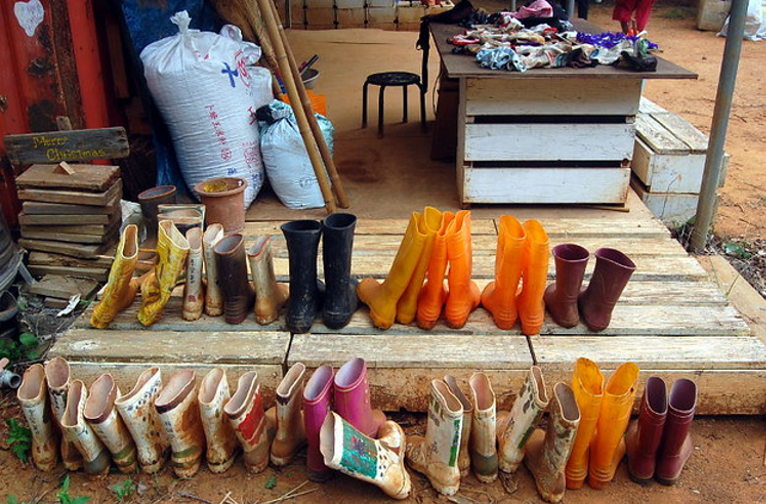In September last year, I was very lucky and surprised to find myself in Taiwan for three weeks. I had two weeks free to travel wherever I wanted – so I put the word out for recommendations of permaculture projects, perhaps where I could volunteer and learn about the permaculture movement on another island (Taiwan is a bit bigger than Wales).
Through a friend of a friend of a friend, I was put in touch with Tammy Turner – a permaculture teacher who has lived in Taiwan for over 30 years. Tammy kindly offered to ask about the network for me, and suggested I may like to share what is happening on the permaculture scene in the UK, as well as about my housing co-operative, Lilac.
A few emails later it turned out Tammy had organised a complete round-the-island tour for me, visiting loads of projects and staying with different practitioners along the way. I was totally blown away by her generosity! This would not be the first time that I would be overwhelmed by the generosity I received in Taiwan.
North Taiwan – urban permaculture adventures
 Stepping out of the airport into the heat of Taipei city, I was helped to navigate the Metro three times by passers by. I was then whisked away quickly into the mountainous outskirts of Taipei, to the community where Tammy and her husband live.
Stepping out of the airport into the heat of Taipei city, I was helped to navigate the Metro three times by passers by. I was then whisked away quickly into the mountainous outskirts of Taipei, to the community where Tammy and her husband live.
Tammy showed me a whole range of community farms & gardens that she has been involved with in Taipei, including a micro garden, built down a side road surrounded by huge tall buildings*, and another on the site of a former car park – the owner apparently deciding he would rather ‘do something good’ with the land! I thought the farm was totally amazing, even though the volunteers I met were a little embarrassed by the tall, uncut grass; they hadn’t managed to cut it yet after the summer when it’s too hot to work. September in Taiwan is a bit like spring in the UK, the beginning of the growing season – except instead of everything dying back it just gets massive!
With Tammy as translator, we set of down the west coast of Taiwan, to Chen Jia farm – literally “1000 hectare” farm but in reality a modest 2.4 acres – a community farm in Hsinchu county. I was shown around by the enthusiastic volunteers, who each coordinate a different area, the tour continuing even as the sun was setting. The project, originally set up as a CSA, now focused on education and farming, making a space for children of indigenous backgrounds, (whose culture does not necessarily chime with mainstream schooling), to learn about food and farming.
In their first few years, they have seen wildlife returning, reduced inputs, and people trading in goods rather cash. Now that the local community are more familiar with them and their work, they are considering the CSA concept again. Here, I also received talks from members of the Taiwan Permaculture Institute (TPI), the equivalent of the Permaculture Association here in the UK. It was great to learn about how they are approaching national networking of permaculture practitioners and to share learning from our different islands.
 Wutong Foundation community garden
Wutong Foundation community garden
We also explored the challenges of greening Taiwan. The Hsinchu county area, like many places, is under pressure from increasing development. On a walk of the local countryside with our hosts, we viewed a huge new dam that has been built to service a recent, large science and technology park. Chen Jia farm volunteers explained that the farm may be under threat as the land becomes more valuable in the eyes of developers, a situation familiar to many of us working on the margins.
Jane, Claire and others from the Wutong Foundation then warmly welcomed me to their beautiful offices in Hsinchu. “We plant trees” is their motto, and they are very creative in how they approach this! Their successful “Travel with a Tree” programme involves inviting railway passengers to take a native tree sapling with them and plant it at their destination. We also visited a number of their urban food forests.
This is a short video of one of them at its early stages, receiving support from the local mayor. It is now maintained by volunteers, enjoyed by local residents, and displays information on permaculture so visitors can find out more.
Down the west coast – parents taking action for the next generation
 On my next stop, in Taichung, Tammy and I visited a community farm started by parents who wanted some outside space for the children to play, as the new local school site was very small. The farm is now run by 20-30 volunteers and a few part-time staff, with rental income covered by grant funding plus renting out small allotment plots to individuals. The parents realised they didn’t know enough about planting to be able to decide how to use the space, so they brought in Tammy to teach some basic permaculture introduction courses and help them co-design the site. The process taught them even more than they intended, opening their eyes to a whole new perspective on the world. They now see the site not only as a place for children to be outside, but a place for becoming ‘interconnected with their community and its relationship with the earth’.
On my next stop, in Taichung, Tammy and I visited a community farm started by parents who wanted some outside space for the children to play, as the new local school site was very small. The farm is now run by 20-30 volunteers and a few part-time staff, with rental income covered by grant funding plus renting out small allotment plots to individuals. The parents realised they didn’t know enough about planting to be able to decide how to use the space, so they brought in Tammy to teach some basic permaculture introduction courses and help them co-design the site. The process taught them even more than they intended, opening their eyes to a whole new perspective on the world. They now see the site not only as a place for children to be outside, but a place for becoming ‘interconnected with their community and its relationship with the earth’.
In its three years, they have integrated a huge range of planting amongst the existing trees (fruit, vegetables, flowers, herbs and rice), implemented many water catchment and storage techniques to help combat the dryness of the site (it is an elevated site with the only sources coming from rainwater and a well installed during the Japanese era). School children and community groups join in short courses on many different topics, and they sell produce from the site and invite local farmers to bring produce as well. They also do many outreach activities, including ‘sustainability obstacle courses’, where members of the public engage in three different mini-workshops and get a free meal at the end.
In Taichung, I stayed with a lovely couple and their little daughter. They had been exploring the idea of living in community, and consciously raising their daughter as a citizen of the world. We shared our experiences – mine of Lilac, theirs of the communities they had visited – including a stay in an amazing Japanese intentional community where they meet every night! (Incredible commitment to community but it hasn’t caught on at Lilac!)
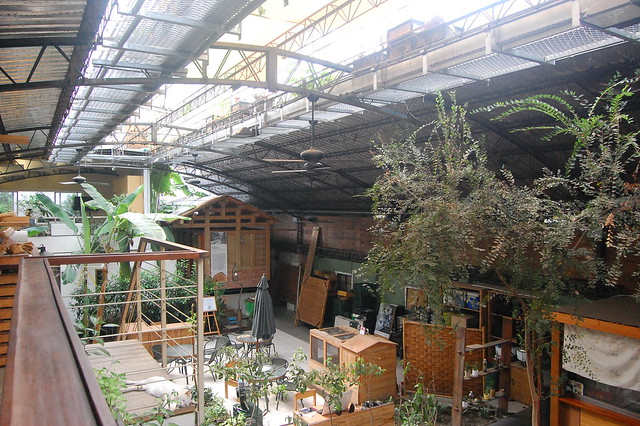 As well as their beautiful restaurant-cum-social space that they built over a year with natural and recycled materials and mainly volunteer labour, we also visited a coffee shop made entirely out of reused materials, including ceilings and floors made from old school chairs.
As well as their beautiful restaurant-cum-social space that they built over a year with natural and recycled materials and mainly volunteer labour, we also visited a coffee shop made entirely out of reused materials, including ceilings and floors made from old school chairs.
From there, we visited Treehope, an amazing economic experiment in community support agriculture slash enterprise incubator. Based in a former shrimp pool restaurant (yes, you read that right), with a giant domed roof a bit like a train station, it is full of mini enterprises based in containers artfully stacked around. Its original aim and main purpose is a CSA-style market run by about 60 farmers and volunteers. They use an alternative currency (V-coin) to pay volunteers, who can receive training and enterprise opportunities (for example, a soya business operates in one of the containers). A coffee shop, compost loos and mini library complement the mini markets and catering-grade kitchens used by the enterprises.
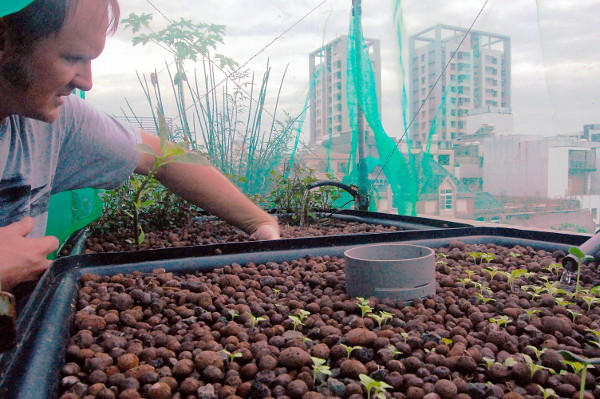 On my next stop, in Tainan, I stayed with Clint and his family. A health situation a number of years earlier meant the family needed to remain living in an urban area, meaning no land to practice permaculture. However, on the top of their 4.5 storey house, Clint has built the most amazing roof garden. Around the aquaponics set-ups and other infrastructure (e.g. solar hot water), the garden is packed with planters.
On my next stop, in Tainan, I stayed with Clint and his family. A health situation a number of years earlier meant the family needed to remain living in an urban area, meaning no land to practice permaculture. However, on the top of their 4.5 storey house, Clint has built the most amazing roof garden. Around the aquaponics set-ups and other infrastructure (e.g. solar hot water), the garden is packed with planters.
Use edges and value the marginal has never been applied so literally. After the initial input of materials and compost, the garden’s soil is now building and is full of life – from in situ composting of the family’s kitchen waste. As well as providing fresh produce, a wildlife haven and amazing views, developing and maintaining the garden has been an important space for physical and mental respite.
By the time I got to Tainan, one week in, I started to get a feel for the community in Taiwan. Zhong-yi from Taichung had put me in touch with a friend of his in Tainan, who was running a second hand market place. Clint and I went along on a relaxed day wandering around the city, it felt really nice to meet new people in these organic ways. I met so many lovely people along the way that there isn’t space to mention them all.
Taiwan’s east coast – an abundance of food, fuel, heat and heart!
 After another astonishingly cheap train ride I was on the east coast, in Taidong, with Earth Passengers** creators Hui-i and Peter. It was truly inspiring to see what had been done on this ¼ hectare space bought 10 years ago. Divided into three areas: the house, the annual garden and the food forest (and ponds), the land sits at a low point, with water draining in from all around, so their challenge is a very wet site!
After another astonishingly cheap train ride I was on the east coast, in Taidong, with Earth Passengers** creators Hui-i and Peter. It was truly inspiring to see what had been done on this ¼ hectare space bought 10 years ago. Divided into three areas: the house, the annual garden and the food forest (and ponds), the land sits at a low point, with water draining in from all around, so their challenge is a very wet site!
The ponds – which they had to keep deepening in the centre – are one way of managing this, as well as water hungry planting around the edges of the site, e.g. bamboo (also a wind break and screen for the road). They have been building the house for 5 years, and also built a workshop in 3 months using only recycled materials from typhoon-damaged houses.
Animals integrated throughout the site provide nutrient cycling, weed control and eggs. The animals have formed their own communities, with inter-species adoptive parenting – one male goose has raised many generations of ducks (which became more vegetarian than usual as a result!). The size of the land is traditional in Taiwan for being a good size for a family to be self-sufficient. More recently, they have expanded to renting a rice paddy to experiment with more broad scale growing, as well as collectively buying a piece of nearby woodland with some friends, where they are learning about keeping bees.
There is so much food here! Mango, jackfruit, bananas, guava, papaya, citrus fruits, avacado, passion fruits, plus coffee and cacao in the shady understory. Having never learned about growing outside of my temperate homeland, I was completely amazed (and frankly downright jealous) that so much grows all year round in Taiwan’s tropical / sub-tropical climate.
Not that it’s all sunshine and ease. At Earth Passengers I was able to actually get my hands dirty and do some work, which was brilliant, but also challenging. Peter showed me how they make the material for the walls of their house, and we spent a bit of time building up some patches. But the heat was extraordinary. So far I had really enjoyed being warm (no emergency jumper needed here), but the combination of being on the hotter east coast plus doing actual physical labour left me chronically thirsty and struggling to stay alert. And if you’re thinking ‘well just work at dawn and dusk’, then be prepared for the mass of mosquitoes waiting to greet (and eat) you.
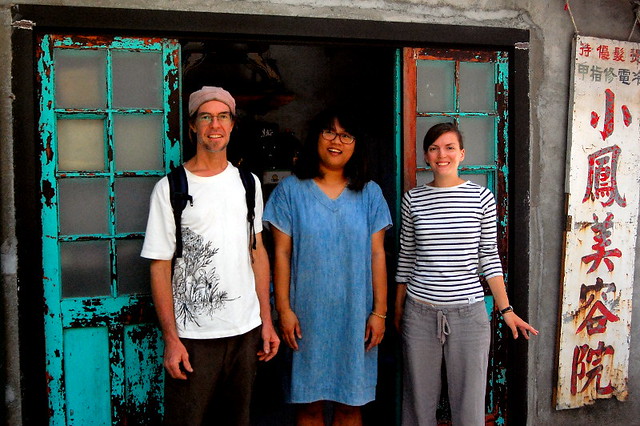 There’s so much more I could say about Earth Passengers (compost loos, chicken runs, the classroom and totally off-grid house), the gorgeous B&B where I stayed and the wider area of Taidong, but time is short and the journey must go on… However, maybe you will see for yourself if you ever visit Taiwan; Hui-i and Peter run permaculture courses at Earth Passengers, and are also organising the International Permaculture Convergence in 2023 (I even got a sneak preview of a potential site for the Convergence, in an indigenous settlement where they regularly host events, some for over 1000 people!)
There’s so much more I could say about Earth Passengers (compost loos, chicken runs, the classroom and totally off-grid house), the gorgeous B&B where I stayed and the wider area of Taidong, but time is short and the journey must go on… However, maybe you will see for yourself if you ever visit Taiwan; Hui-i and Peter run permaculture courses at Earth Passengers, and are also organising the International Permaculture Convergence in 2023 (I even got a sneak preview of a potential site for the Convergence, in an indigenous settlement where they regularly host events, some for over 1000 people!)
From Taidong, I continued north to Hualien and was greeted at the station by Joyce, my next host. ‘Breathing Life’ is written on Joyce’s pop-up name card (exchanging name cards is custom in Taiwan) and spending 5 minutes with her you can see why, her energy is infectious. In Lilac, we learned from Diana Leafe Christian that the three important pillars of a healthy community are good governance, good communication and ‘community glue’ – all the fun stuff that makes you actually want to live together and makes the work worthwhile! To me, Joyce is like community glue embodied. Walking out to breakfast one morning, she was waving and hello’ing to all the ‘aunties’ out and about, buying ingredients for the community meal she was hosting that evening. Like all my hosts, I was blown away by her generosity and hospitality. Joyce has a guest room you can hire in an airbnb-style way – I don’t have a link but would happily put you in touch if ever needed.
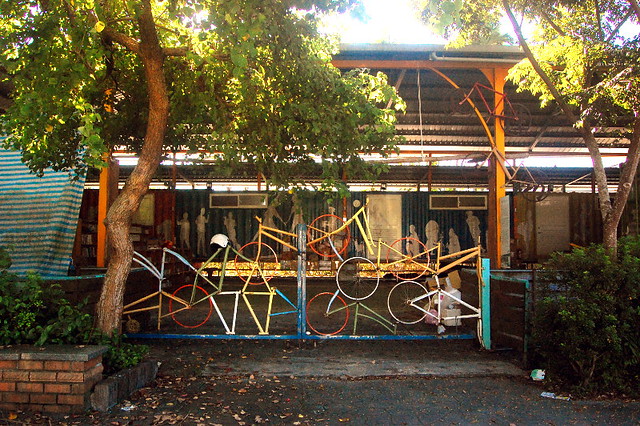 I had been invited to give a lecture on Lilac at a Buddhist University in Hualien by another permaculture teacher, Chiu Yi-Rue. After the lecture (and an amazing lunch), we sat in a 7/11 and Yi-Rue told me about his work and life in permaculture. Yi-Rue has integrated permaculture practice across all areas of his life: from co-instigating community education in farming, economics, co-operatives, yoga, culture and of course PDCs, and creating a forest garden at the University where he teaches, to his involvement the Hualien Permaculture Association – a regional network of volunteers, teachers, and friends that have built a learning centre together – and beyond, to his work teaching permaculture with Rosemary Morrow in the Himalayas.
I had been invited to give a lecture on Lilac at a Buddhist University in Hualien by another permaculture teacher, Chiu Yi-Rue. After the lecture (and an amazing lunch), we sat in a 7/11 and Yi-Rue told me about his work and life in permaculture. Yi-Rue has integrated permaculture practice across all areas of his life: from co-instigating community education in farming, economics, co-operatives, yoga, culture and of course PDCs, and creating a forest garden at the University where he teaches, to his involvement the Hualien Permaculture Association – a regional network of volunteers, teachers, and friends that have built a learning centre together – and beyond, to his work teaching permaculture with Rosemary Morrow in the Himalayas.
In each area, Yi-Rue had clarity of purpose (“with permaculture, everyone can empower themselves to be a designer”) combined with a humbleness (“everyone is leader, no-one is leader”) that I found really moving. Each time I remember it, our conversation reminds me again of the fundamental importance of co-operation, lifelong learning and kindness.
Back to the beginning – a new start with a fresh perspective
Finally, back in Taipei, I give my final talk on Lilac to another brilliant and engaged audience, this time assembled by TPI. I had given the slideshow about ten times at this point, sometimes to individuals and sometimes to audiences of 40+, and each time was a humbling reminder of how much I appreciate living in a creative and supportive community, and what it a privilege it had been to share that with new friends in Taiwan.
The two weeks had flown by so quickly, and yet, many months on, I still hold the experiences and learning close to me. I cannot thank the people I met enough, for sharing your projects and experiences with me, for hosting me, and for organising on my behalf. I have to give my extra special thanks to Tammy Turner, for welcoming a complete stranger into her networks on the basis of an email. I hope I can return the favour to you all, or pass it on to others who come my way.
* Featured in the first minute
** Scroll down the page for some information in English


